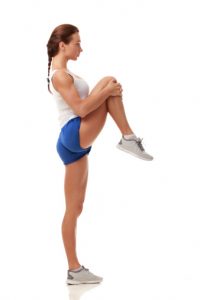 I recently received a question from Kylie, a fellow Pilates teacher, regarding snapping hip syndrome and what to do to make it go away during exercise.
I recently received a question from Kylie, a fellow Pilates teacher, regarding snapping hip syndrome and what to do to make it go away during exercise.
Here are her comments and question:
“I have some very hip flexor dominant students that suffer from hip click in quite a few of the Pilates exercises, big one being Leg Circles and virtually anytime they extend their legs out away from the body. I cue to bring balance with the antagonist muscles (tva and Glutes) but am still having issues. Could you guide me in helping these people a little more effectively? (I do ask them to stretch with a lunge prior to class, and even do a recumbent jazz attitude movement before leg circles.) So is there something I am not seeing or doing? Any advice would be greatly appreciated.”
I then dove into a folder on my computer to find an article in hiding that I had written, but never posted on my blog – think I may have posted in on a Podiatry forum where I read a clicking hip question! Interesting to me that Podiatrists are also dealing with this issue with their patients. It doesn’t do anybody any good for me to keep things a secret! So I hope that for those of you out there challenged with clicking hips – you will find some of this information useful. Please let me know how it goes with teaching or doing Pilates exercises and using this info to get out of the hip click!
Here are my thoughts:
In my 15 years of experience teaching Pilates, when a client experiences “clicking” or popping in the hip with movement, strengthening the pelvic floor muscles and increased lower core support, as well as focused exercises to improve hip mechanics with a softer (un-gripped) rectis femoris muslce will assist with this issue.
I was really blessed that when I started learning Pilates my first teacher, David Mooney, spent many, many hours during my private sessions helping me learn how to use my quads less and everything else more to support movement – especially when doing Pilates exercises that involved moving my legs away from and back to center, and not gripping the fronts of my thighs! I then spent a ton of additional hours propping my feet up on things when I practiced on my own to re-train my body to relax my rectus femoris (top of the thigh hip flexor) , and support the weight of my legs in the air with my abdominals, psoas (under the thigh hip flexor), hamstrings, and glutes. Then later on, from my mentor Dianne Miller, I got a greater appreciation of the value of an appropriately engaged pelvic floor to also benefit better support and reduce hip clicking.
In a Mat class there are a few things I do immediately to modify the One Leg Circle, until clients can make it happen with no noise or aggravation.
1. Decrease the size of the circle and range of motion of the leg while it’s circling. A smaller range of motion should temporarily solve the problem, and allow the client to reach the leg longer creating more free space in the socket for movement, and helping them focus on the support and stability needed through the pelvis and “standing” leg.
2. Bend the knee while doing the circles. This shortens the lever and will adjust where the ball is sitting in the socket through the range of the circle. It also takes some of the work out of the quads and shifts support to the hamstrings so the leg can swing more freely from the hip during movement.
3. Use the support of a strap and assistance of the arms to help hold up the leg. If the hamstrings are very tight (back of the thigh), or the quadriceps are gripping to pull the leg around and up (front of the thigh) the leg cannot move freely from the hip because of the tension caused by muscle contraction and over-holding at inappropriate moments.
If I’m working privately with a client and have access to the Pilates Trapeze Table, the use of one leg spring to practice circles provides a similar support along with resistance to strengthen the leg throughout the range of movement.
In fact, all the Pilates equipment exercises where the legs are in a strap or spring, or knees folded over the roll down bar, are helping to retrain the body to reduce issues with clicking hips – IF a client is cued to keep the pelvic floor active, work from the back of the legs to extend and return, and maintain a softer “un-gripped” rectus femoris.
This is why Pilates is a system. Clients will benefit the most by working on both the equipment and Matwork to help retrain the body, undue bad habits, and strengthen the most efficient muscles for functional movement. It is extremely difficult to retrain the quads to let go when they’re the guys used to doing all the work when the legs are extended, unsupported in space.
From the tweaks to the Leg Circle exercise listed above, education about the benefits of using and finding the Pelvic Floor is the next thing to incorporate into classes or client training programs. I teach how to find and use the Pelvic Floor as an exercise all by itself first, and then add this into other exercises until clients can confidently find and fire it at will! Contracting the pelvic floor for support during exercise helps to take the pressure off the hip joint, frees up the ball in the socket, and allows movement without the noise or aggravation. It’s the front and back walls of pelvic floor support (tailbone to pubic bone connection) that is most difficult to find and use that is needed for free hip motion.
Then, watch your clients walk across the room. Do the thighs stay in front of the body? Or swing evenly with one leg moving behind the torso (the rectus femoris is releasing on every stride.)
With poor gait mechanics, a shortened stride, slightly posterior tilted pelvis, and overuse of the rectus femoris (one of the four quadriceps muscles,) the thigh bone is held to far to the front of the socket. Try to move the leg in a free range and it’s not going to happen easily until the pelvis and hip muscles have a different relationship.
In my experience – this postural and mechanical use of the body is apparent in many if not most of the people who have walked through my door for Pilates. We spend too much time sitting, have lower back issues, and don’t take much time to stretch.
The great news is things can quickly improve with an understanding of how to find and use the pelvic floor as well as exercises to get a better understanding of posterior/inferior ball & socket placement, how to move the ball in the socket, and how to move the socket around the ball. If the leg is working mechanically well from the hip, the foot and lower leg have a better shot at good mechanics too!
Not only is the clicking apparent on one leg circles, but for some clients doing the Roll Up, or Neck Pull, you may see one or both hips make a funny, clunky shift in the transition from laying down to a seated position. The reason for this again might be not enough pelvic floor, clients are “hanging off their hip flexors” and trying to move.
Think about the levers of the body –what parts of the body are moving and supporting during exercise?
- In the One Leg Circle, the thigh (ball & socket) are moving with a stable pelvis.
- In the Roll Up, the pelvis is moving (around the ball & socket) with a stable thigh.
So you’ve got movement from above, the ball and socket, and movement from below…the support to move is the same! More pelvic floor action (especially the connection between the tailbone and pubic bone) will free up the movement and reduce / eliminate the “clicks.”
Hope this info is helpful! Any instructors or Pilates clients out there who would like to comment on things you’ve done, cues you’ve found helpful, or exercises that have been beneficial to assisting with the saying good-bye to the clicking hip issue, please share!!!


For sure I can feel for a ton of the information that you have on your site. I also found that some of the statements that people made were insightful.
How do you do? We simply love your beautiful editorial thanks and pls continue it
I visit your website every once in a while and I just have to mention that I like your template!
Great website. Plenty of useful info here. I am sending it to several buddies ans also sharing in delicious. And of course, thank you on your sweat!
Thank you, this was very helpful! sharing on FB. Regards Richard.
Hi Richard, thanks for the FB shares! Happy to be a resource for helpful exercise tips.
Hi! Very informative article. I appreciate your reminder of the importance of the pelvic floor muscles. In regards to using the quads less, in single leg circles, for example, I was taught to cue a slight external rotation from the hip socket of the leg in the air.